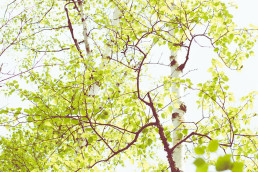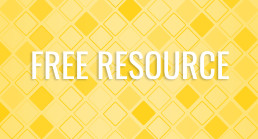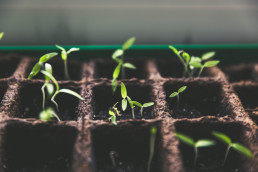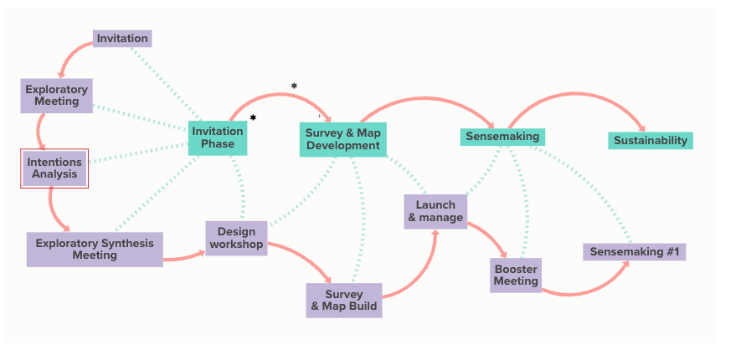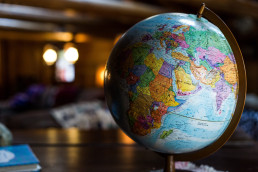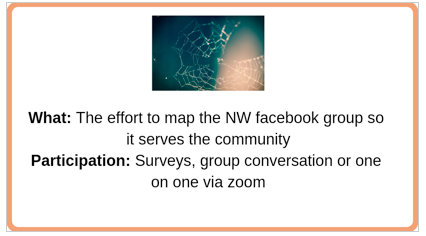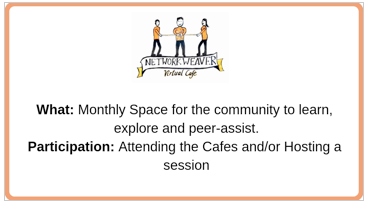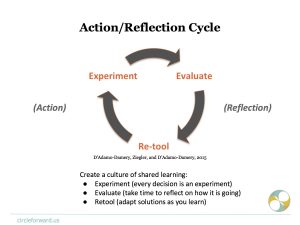What’s Our Job?: Getting Clear on Network Functions
[ap_spacing spacing_height="20px"]
As I’ve worked with a variety of social change networks to launch or transition from one stage to another, I’ve been guided by the following formula:
[ap_spacing spacing_height="20px"]
Form follows function follows focus
My experience is that many groups and initiatives can get very concerned about structure – How will we make decisions? Who will be members? What is expected of them? What do they get in return? These are important questions, and they deserve a fair amount of time tending to them. What can bog many groups down at this stage, however, is that they have not sufficiently sorted out the functions of the network, how it creates value, if you will, which has important implications for form. And if the group is not clear on its focus (purpose, animating goal, mission), this can be that much more perplexing.
So I’m spending more and more time with networks sorting out their core “jobs,” with a few additional guiding mantras, including:
[ap_spacing spacing_height="20px"]
Do what you do best and connect to the rest.
The value proposition of change networks in my mind is that they add value to a broader landscape of activity, not that they come in and try to take over. Even if this is not the intent, groups can spend little time figuring out what already exists “out there,” what efforts are underway, what other collective efforts are operating. This lack of awareness risks creating unnecessary and unhelpful duplication and competition.
From an ecosystem perspective, each living organism finds a particular niche (what it does best and where) and contributes to the broader whole. I recently met with a network that did some important work sorting out what the jobs of the network as a whole are versus the functions of its individual members. For example, members decided it is NOT the work of the network to create curricula; that’s what members do. It is the job of the network to disseminate these, to make them more broadly accessible and to create a portal that draws more attention to a variety of educational resources that can meet a diversity of needs. Furthermore, the network decided its job was NOT advocacy, since another group already did this work quite well, but it could provide a great service alerting members and others to important campaigns and organizing efforts.

Another guiding mantra:
What value can we create through connection and flow?
There are really the two main ways that networks achieve what are called “network effects” (such as resilience, adaptation, small world reach …). If we are not talking about how a network does its work through leveraging, adding and shifting patterns of connection and flow, then we really are not bringing a network mindset to net work. When we do, this can help illuminate areas for adding and creating value – for example, bridging across various kinds of boundaries, temporal, geographic and cultural, or amplifying otherwise unheard or less resourced members.
Recent work with another network yielded the following list of functions, which they are continuing to play with:
[ap_spacing spacing_height="10px"]
- Build trusted relationships between multiple sectors and communities [ap_spacing spacing_height="10px"]
- Convene partners across state and sectors [ap_spacing spacing_height="10px"]
- Generate conversation among diverse partners [ap_spacing spacing_height="10px"]
- Identify newly arising (systemic) barriers so they can be addressed [ap_spacing spacing_height="10px"]
- Provide greater access to technical assistanceproviders [ap_spacing spacing_height="10px"]
- Facilitate access to relevant expertise (including lived experience), information and resources [ap_spacing spacing_height="10px"]
- Disseminate information about innovative approaches and policy priorities [ap_spacing spacing_height="10px"]
- Disrupt the status quo in the name of creating system change (ex. support litigation) [ap_spacing spacing_height="10px"]
- Contribute to movement; use innovation and creativity to inspire people to action [ap_spacing spacing_height="10px"]
- Curate relevant data, information, planning documents and other resources, and ensure community input is reflected [ap_spacing spacing_height="10px"]
What about you and your network(s)? What functions are you finding add the greatest value? How are you determining what you do best as a network, and where, and how you contribute to others?
originally published on 9/12/18 at Interaction Institute for Social Change
Iniciandose En La CAJA DE HERRAMIENTAS De La AUTO-ORGANIZACIÓN
Spanish translation by Ulises Aguila
( for the English language version of the Self Organizing Toolkit click HERE )
Iniciandose En La CAJA DE HERRAMIENTAS De La AUTO-ORGANIZACIÓN incluye un conjunto de simples acciones que usted puede tomar para comenzar uno mismo-organización en tu organización o red.
La auto-organización sucede cuando cualquier individuo o agrupación:
- Visualiza una oportunidad para hacer un cambio o tratar de hacer algo diferente [ap_spacing spacing_height="10px"]
- Siente que puede iniciar una acción[ap_spacing spacing_height="10px"]
- Encuentra diferentes aliados de redes más grandes para buscar unirse o colaborar
- Experimenta poniendo en marcha acciones pequeñas
- Accede a los recursos que necesitan intervenir[ap_spacing spacing_height="10px"]
- Pasa el tiempo necesario observando atentamente lo que está sucediendo, resumiendo, aprendiendo de esa experiencia y analizado lo que se ha hecho, todo esto para empoderar de una mejor manera el siguiente paso[ap_spacing spacing_height="10px"]
- Comparte lo que ha aprendido con una red más grande[ap_spacing spacing_height="10px"]
Visionary Organizing Lab
Visionary Organizing Lab began in 2016 as a volunteer based project conducting workshops on building beloved communities and a new economy.
Since we began, research across disciplines and the political spectrum has increasingly demonstrated that the global economy is reaching its systemic limits and is in terminal crisis.
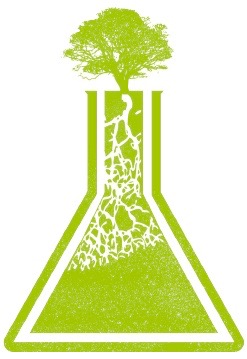
Consequently, we are entering a global transition as significant as that from feudalism to capitalism. This knowledge, combined with an evaluation of our pilot, has led us to conclude that we need a consistent research program to fulfill our mission. Visionary Organizing Lab is therefore evolving into a staff based think and practice tank, conducting research on the global economy and on projects that a new system might emerge from.
We will distribute our findings through briefings, publications, short documentaries, and incorporate them into future trainings and workshops.
[ap_spacing spacing_height="35px"]
What do you mean the global economy is reaching its systemic limits and is in terminal crisis?
[ap_spacing spacing_height="10px"]
Despite the idea that globalization is new, from its inception capitalism has been a global system linking every area of the world in which it is felt. When Columbus arrived in the West Indies, he was laying the initial patters of a global economy. As the Portuguese began to trade enslaved Africans throughout the western hemisphere, these global connections and patterns were deepened. When the British, French, and Dutch began to battle for control over these patterns and connections, the connections themselves became more solid as did the place of North America in this new world. With revolutions in what became the United States and France, a form of representative democracy was born that tied these global economic patterns together politically. Creating laws that enabled economic growth on a world scale, these political relationships between nations created a way to maintain the system’s equilibrium and facilitated the growth of an entire economic and cultural system that eventually came to cover the entire world. We call this system the “modern world-system.”
As long as the world’s industrial capacities remained primarily concentrated in Europe and North America, the system had what it needed to grow and create profits. However, when industrialization spread to the global south and the global north began deindustrializing, it greatly de-ruralized the world, spreading pollution worldwide and employing what had been a cheap, rural reserve of workers.
Consequently, the supply of low wage workers needed to expand profits and the ability of firms to pollute the environment without financial and human costs have both been exhausted. As a result of these trends, we are faced with a climate crisis of epic proportions and the system is quickly reaching its limits for the further accumulation of capital and growth.
Approaching these limits, the system is in terminal crisis, increasingly unpredictable and subject to huge crises and fluctuations. As with all systems in this terminal state, opportunities exist to create a new system(s). Since launching our pilot we have come to understand this historical period as one of “systemic transition.”
[ap_spacing spacing_height="35px"]
What do you mean by “systemic transition?”
[ap_spacing spacing_height="10px"]
All historical systems have three phases:
emergence, normal functioning, and structural crisis. Capitalism emerged 400-600 years ago, functioned normally from 1648-1968, and entered its structural crisis between 1974-2008. A system enters structural crisis when, typically in response to a prior crisis, its equilibrium shifts too far from its normal center. At this point, a system is increasingly characterized by crises and chaos that can only be resolved by a new system with a new equilibrium.
This period when a system is reaching its limits and the emergence of a new system(s) with a new equilibrium is being worked out is called a systemic transition. Whether we like it or not, capitalism and the entire modern world-system is transitioning into something else because it is in structural crisis. Importantly, its transition presents an opportunity for humans to create a new system rooted in the values of love, dignity, and sustainability.
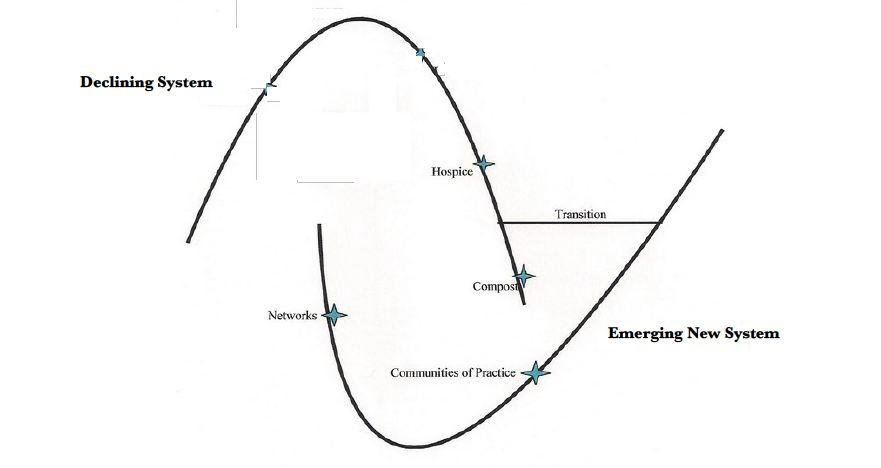
[ap_spacing spacing_height="35px"]
So there’s hope? How might we transition into a new, more loving economic system?
[ap_spacing spacing_height="10px"]
Yes, the basis of all our work is hope and a belief that the human spirit is strong and wants to grow and develop. We also believe that the willingness to assume responsibility for systemic transition is something human beings need great support to do. Most of us lack confidence, lack a sense of being powerful, and lack the ability to think in systems based ways. To transition into a new, more loving economy, human beings can and must transform these things about ourselves. Visionary Organizing Lab is committed to facilitating these transformations.
Creating a loving system will require patience, imaginative experiments, and a process of trial and error. Systems emerge very slowly, result from repeated patterns coalescing over time, and seldom emerge from a blueprint. Rooted in visionary organizing, these experimental projects must be designed to meet people’s material and spiritual needs, potentially beginning with questions like, “What effective ways for providing people with a means to sustain themselves other than wage labor might we create or already exist?” or, “What effective ways of community based problem solving already exist or might we create to eliminate the need and justification for police?”
Once experiments have some tangible results, when linked with similar projects, they can form networks of people and projects working to meet human needs absent a culture of domination. Building on these networks, a new system will require the emergence of intentional communities of practice, where knowledge about how to better meet each other’s needs absent a culture of domination can be furthered. At this second stage of a system’s emergence, developing communities of practice requires a group of people who are self-consciously committed to developing a new system.
By continuing and advancing these experiments in communities of practice, these projects can be taken to scale, and the links between them can form what Meg Wheatley and Deborah Frieze have called “systems of influence.” With evidence that this system of influence can meet people’s needs, these once experimental projects can become accepted norms. Transitioning into a new system will require bringing more people into these accepted norms and providing hospice care for the capitalist system, essentially turning it to compost. The diagram below illustrates the emergence of a new system and its relationship to a declining system:
[ap_spacing spacing_height="35px"]
What is Visionary Organizing and what do you mean by hospice care for the old system?
[ap_spacing spacing_height="10px"]
In the same why that hospice care is a means to make someone dying more comfortable, providing hospice care for the dying system involves making life more comfortable for those affected by its death. Systemic transition will be painful for everyone who experiences it. A system in structural crisis is unpredictable, chaotic, and crisis prone. When the economic system that organizes your life goes through structural crisis, life can become increasingly hard. To make that transition more comfortable, hospice care for a dying system looks like basic progressive policies for things like universal health care and guaranteed access to food, water, and shelter.
In contrast to the kind of organizing needed to provide hospice, visionary organizing is a philosophy and practice rooted in the belief that human beings have spiritual and psychological desires to grow in ways made very difficult by capitalism, racism, and patriarchy. Visionary organizing assumes that by starting with a collective vision of what a new world might look like, then working backwards to figure out what kinds of projects might make reality more closely resemble that ideal, people can collectively build a new system under which the human spirit can grow and flourish.
[ap_spacing spacing_height="35px"]
That sounds nice, but what does it look like?
[ap_spacing spacing_height="10px"]
Visionary organizing looks like living in a food desert and starting to grow food for an entire block using whatever land is available and coming to understand that practice as a potential foundation for a new economic and social system.
Visionary organizing looks like responding to police brutality not only by protest but by also creating neighborhood conflict resolution teams and practicing community based conflict resolution so that people don’t need to call the police to resolve conflicts, and seeing this practice as a potential basis for a new culture.
Visionary organizing also looks like meeting people’s economic needs through things like barter economies, alternative currencies, and community production, and seeing these practices as potential bases for a new economic system. These are just a few examples of what visionary organizing concretely looks like.
[ap_spacing spacing_height="35px"]
Oh, that approach makes a lot of sense. So what do you do? Why do you call yourself a lab?
[ap_spacing spacing_height="10px"]
We call ourselves a lab because we experiment with ways to spread awareness of systemic transition and skills needed to facilitate it. Our primary laboratory are trainings and workshops that we call praxis labs.
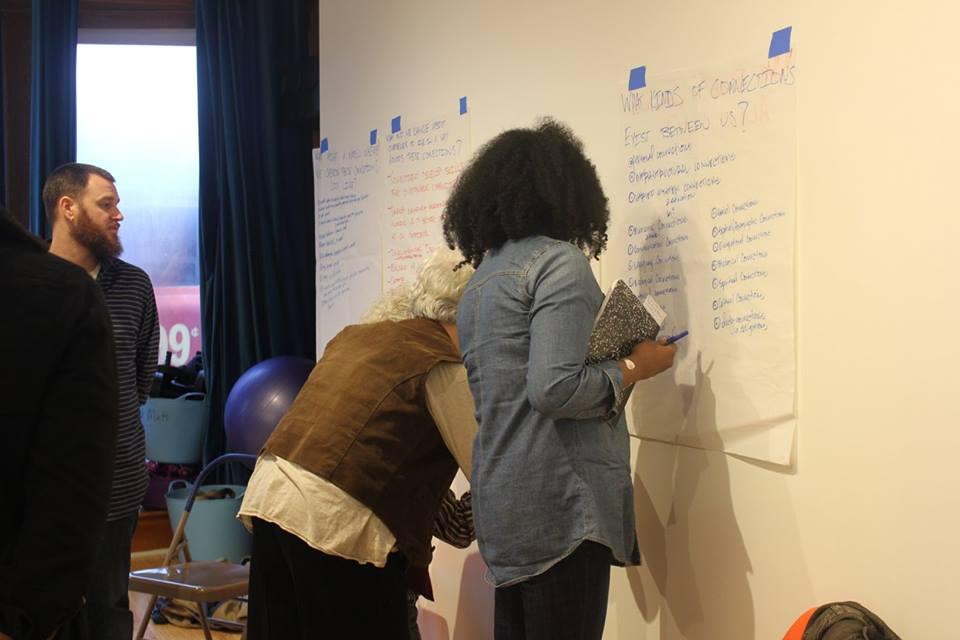
In praxis labs people collectively experiment with theory, reflection, practice, and the relationship between all three. People are connected to their knowledge of the world around them, supported in understanding how who they are is connected to the larger world, and connect with how they and others might become more human human beings by experimenting with practices that can become a basis for a new system.
For example, a praxis lab on visionary organizing helped Rev. Kelly Steele from Savanah, GA, “to see that our great grandmother’s stories and landscape have direct ties with our current story and landscape,” because “the issues we face today are a direct product of Western imperialism and disconnection from the land, each other, and a sense of community.”
Corbin Leadlein, an organizer and activist from Brooklyn, NY attended four of our pilot praxis labs and came away, “from all of them having engaged in thoughtful, challenging, and inspiring discussions that have helped me to reflect on my role in creating beloved community.
The discussions are participatory, dynamic, and both focus on participants’ personal experiences while also appreciating how our stories fit within trends of historical development. I appreciate that the workshops conclude with participants coming up with tangible actions and projects that can be taken up in their respective neighborhoods and communities.”
To facilitate this learning process, praxis labs create spaces for reflection, conversation, and exchange. In praxis labs we put our reflections on everyday life in conversation with larger structural and historical phenomena. Through that conversation, we create space for people to appreciate their unique capacity to contribute to the world and come to see how personal and larger social transformations are connected.
As the above experiences show, this process creates conditions for people to imagine what we and our communities are capable of, as well as develop practices to facilitate these possibilities and understand their systemic implications.
[ap_spacing spacing_height="35px"]
That’s impressive. How does the research you propose compliment praxis labs?
[ap_spacing spacing_height="10px"]
After evaluating our 18-month pilot six points became clear:
People are excited to think through the creation of small projects to build community. It is very easy for people to see these small projects as “feel good” things that lack larger significance. When involved in the co-creation of a systemic understanding of history, people quickly understand that if small projects are networked together they can form the basis of a new system. In co-creating this systemic understanding of history, people quickly grasp that despite their feelings of powerlessness, they actually have great power to create projects and contribute to building a new system.
Despite this awareness of their creative capacity and power, imagining and coming up with actual projects within a systemic context to collectively experiment with is a major challenge for most people. Already existing filmed examples of projects can be useful for imagining visionary projects.
However, because these examples are disconnected from the systemic understanding of history co-created by praxis lab participants, they tend to undermine the kind of systems thinking developed in praxis labs and necessary for the emergence of a new system.
From these six observations, we have concluded that we can best support people in visionary organizing by incorporating examples of already existing projects into praxis labs within the systemic understanding of history co-created in praxis labs. To make our praxis labs more effective, we aim to create short documentaries and publish briefings that place visionary projects in the framework of systemic transition.
[ap_spacing spacing_height="35px"]
What other roles will the research, short documentaries, and publications play?
[ap_spacing spacing_height="10px"]
Systemic transition is a very difficult idea to grasp and accept. Our hope is that our short documentaries and briefings can make it easier to grasp, accept, facilitate, and live through. By presenting people with an easily digestible picture of the historical evolution of the modern world-system, we hope to provide people with a language to help them understand and accept the crises and transformations surrounding them.
By providing them with a story of people who have come together to build a barter economy or an alternative currency, for example, we hope to provide them with an example of something they can do with their neighbors to meet each others needs without money.
By documenting and promoting the way that participation in these projects has transformed them, we aim to provide people with hope and to support them develop an image of themselves as leaders in the creation of a new system.
We are also planning to use these materials to recruit research and activist fellows, convene conferences, and generally promote the idea of systemic transition and the possibility of a more loving economy and world-system.
[ap_spacing spacing_height="35px"]
This sounds like a really important project. How might I help? Can I get involved?
[ap_spacing spacing_height="10px"]
There are several ways you can get involved.
- You can book Visionary Organizing Lab to lead a praxis lab for your organization or volunteer to organize one in your community. We will come to any group of people that want to learn about systemic transition. Booking information can be found at: https://www.alliedmedia.org/visionary-organizing-lab/booking
- You can become a monthly sustainer of Visionary Organizing Lab or make a one-time donation at: https://www.alliedmedia.org/visionary-organizing-lab/donate
- All donations are tax-deductible and processed through our fiscal sponsor, Allied media Projects.
- You can follow us on twitter and facebook, discuss systemic transition with others, and contact us for more information.
Expanding the Benefits of Networked Work
What began as exasperation with dysfunctional organizations and boring meetings became a quest to discover what is possible with collaborative, networked work. My discovery process has led me to see that collaborative learning is what we can put at the center of how we work. We need a way to see how our individual work connects with larger communities and to realize that each of those relationships can be an avenue for information, resources, and new ideas to be exchanged. To help with seeing the relationships and potential for collaborative learning, I have developed this framework:

With good design and facilitation, each
meeting and how we do work can generate benefits and connect learning
within these dimensions.
Below, I highlight the range of benefits that good collaborative work can generate. Many tools and methods are out there for how to do this and I have linked to blogs if you’d like to learn more.
[ap_spacing spacing_height="10px"]
Individual Benefits
- Help me advance the work currently on my plate. [ap_spacing spacing_height="10px"]
- Make new connections and/or strengthen relationships that can help my current or future work. [ap_spacing spacing_height="10px"]
- Deepen my understanding about the community, issues, and/or larger systems I am working within and help me see my niche, e.g., how can my skills best contribute to what is needed in my organization/community. [ap_spacing spacing_height="10px"]
- Access new information and resources; spark my curiosity about new areas to learn about or invest in. [ap_spacing spacing_height="10px"]
- Clarify my own thinking; reflect and make meaning of my experience, e.g., by having an opportunity to talk and be listened to and have meaningful conversations. [ap_spacing spacing_height="10px"]
Micro-Collaboration/Relationship
Benefits
- Enable people to find each other who have the same or complementary interests. (See Quick Maps, Closing Triangles, and Network Mapping) [ap_spacing spacing_height="10px"]
- Deepen understanding of other’s work, ideas and perspectives and vice versa (e.g., connecting across siloes, deepening dialogue). (See 1-2-4-All and World Café) [ap_spacing spacing_height="10px"]
- Create opportunities to spark new “micro-collaborations” (e.g., two or three people working together, meeting for coffee to find ways to help each other’s work, sharing information/making introductions). (See Micro-Collaborations) [ap_spacing spacing_height="10px"]
- Strengthen trust, care, and good will for each other. [ap_spacing spacing_height="10px"]
- Build skills in listening and collaborative leadership. (See Listening) [ap_spacing spacing_height="10px"]
“It's not just about delivering
content to members, it's about the convening power to help members
discover each other.” - Clay Shirky
Joint Work Benefits
- Access the best thinking of each participant and enable these ideas and experiences to synthesize and cross-pollinate. [ap_spacing spacing_height="10px"]
- Align a group around a shared purpose.[ap_spacing spacing_height="10px"]
- Connect and amplify many voices to have a stronger common voice. [ap_spacing spacing_height="10px"]
- Gather ideas and prioritize them to determine the wisest strategy and actions to take now. [ap_spacing spacing_height="10px"]
- Do more together than anyone could alone. [ap_spacing spacing_height="10px"]
Connecting Networks and Communities
of Practice
Each member of a
team/organization/network can be a conduit to share learning from
this work into their other networks and learning communities and vice
versa. Here are some examples: (See Invest
in the Field and Peer
Learning Network)
- Teams or organizations can connect to others doing similar work for learning exchange (e.g., community of practice). [ap_spacing spacing_height="10px"]
- Each role in an organization can connect to learning communities of those who do that same role for sharing best practices and learning (e.g., urban sustainability officers, non-profit executive directors, facilitators). Professional associations, following and sharing on social media, and communities of practice are all places to share learning. [ap_spacing spacing_height="10px"]
- Each team or organization is nested within a larger one (e.g., a town is part of a county, which is part of a state). Insights and learning can be shared within and across these levels.
- Various processes and tools to do work each have networks to share and exchange learning (such as this community of Network Weavers, local Meet-Ups of people who use WordPress, and Art of Hosting, a global learning network of thousands connecting on how to host conversations that matter). [ap_spacing spacing_height="10px"]
Collaborative Learning is at the
Center
Each of these four dimensions
contribute to collaborative learning for the whole group and that
learning can generates benefits for each dimension. At each level,
information, conversation, and exchange flow in all directions to
increase the collaborative learning potential of the group.
Learn More
On April 17th, I am providing an
on-line workshop called Working
as an Ecosystem that will offer practical methods for working in
ways that generate these multiple benefits.
Lista de verificación Network Weaver
[ap_spacing spacing_height="15px"]
A spanish/english version of the Network Weaver Checklist, translated by Ulises Aguila.
[ap_spacing spacing_height="15px"]La Lista de control de Network Weaver se ha revisado de la versión del Manual del NW y en formato pdf para facilitar la impresión.
[ap_spacing spacing_height="15px"]Network Weaver Checklist is revised from the NW Handbook version and in pdf format to make it easy for you to print. This checklist is great to give to people in your network at a face-to-face gathering. [ap_spacing spacing_height="15px"]
For the english only version click here.
[ap_spacing spacing_height="15px"]
Network Weaving Facebook Group Social System Map
[ap_spacing spacing_height="15px"]Our next call is from 9-10:30 a.m. CT on April 2nd.
[ap_spacing spacing_height="15px"]Our goals for the call are [ap_spacing spacing_height="15px"]
- People get to connect/build relationships with each other[ap_spacing spacing_height="10px"]
- Review what we’ve discovered so far;[ap_spacing spacing_height="10px"]
- Generate questions based on the feedback on intentions and what we want to know (based on the information from our first call) [ap_spacing spacing_height="15px"]
Here's the registration link and the report back that we'll be using to discover the community. [ap_spacing spacing_height="15px"]
Best, [ap_spacing spacing_height="15px"]
Sarah Ann Shanahan, The RE-AMP Network
Report Back #1
Exploratory Meeting (February 13, 2019)
Authored by Jim Best (best.jim@gmail.com)
[ap_spacing spacing_height="20px"]
Introduction[ap_spacing spacing_height="15px"]
This Report Back captures the learnings of an initial Exploratory Meeting on Zoom held by MasterMappers to assess interest and start to understand some of the purposes that are alive in the Network Weaving Facebook community. The draft Report Back has produced generative conversation in the comments (left intact here) that will help us move forward in a subsequent Exploratory Synthesis Meeting in April. Thanks all!
[ap_spacing spacing_height="15px"]47 registered for the 60 minute Zoom event, 24 attended, and 13 expressed initial interest in some kind of co-production of the social system map with the Master Mappers going forward.
[ap_spacing spacing_height="15px"]The agenda of the meeting:
[ap_spacing spacing_height="15px"]
- (05) Welcome[ap_spacing spacing_height="10px"]
- (05) 27 Intros captured in chat (simultaneously)[ap_spacing spacing_height="10px"]
- (05) Orientation to the mapping project[ap_spacing spacing_height="10px"]
- (20) Small group breakouts of 3 to address 3 questions (Google Doc capture)[ap_spacing spacing_height="10px"]
- (05) Reflections on the experience[ap_spacing spacing_height="10px"]
- (05) Demo of sumApp and Kumu mapping tools[ap_spacing spacing_height="10px"]
- (10) Next steps. Poll for interest in co-producing a map[ap_spacing spacing_height="10px"]
- (05) Plus/Delta & Closing[ap_spacing spacing_height="15px"]
There are a set of Exploratory Meeting Notes created by the participants as we broke out into small groups. This level of detail is for hardy souls! It provides a look at the actual conversations in the words of the participants rather than MasterMappers’ summary of them. I’ve tried to provide value at this summary level while still giving a flavor of this vibrant meeting.
[ap_spacing spacing_height="15px"]The following sections use a “What? So What? Now What?” format to move from observation to meaning to action. See more about the rationale for this framework on the Human Systems Dynamics website or the Liberating Structure by the same name.
[ap_spacing spacing_height="25px"]
What?
The participants spanned 5 countries and 9 states comprising a variety of backgrounds (intros captured in the chat box).
[ap_spacing spacing_height="15px"]People come to the NWFB group with a variety of intentions. The recent Virtual Network Cafe#1 small group discussions surfaced some of these same intentions. That event provided a useful cross-validation and we look forward to more of these kinds of discussions where we begin to form an identity and discover purposes.
[ap_spacing spacing_height="15px"]We focus on intentions because sufficiently strong purposes and opportunities attract the passion and energy that lead to the necessary relationships and resource-sharing required for action. What are those intentions?
[ap_spacing spacing_height="5px"]Intentions
We asked, “Why did you join the Network Weavers Facebook group and what do you hope to get out of this community?”
[ap_spacing spacing_height="15px"]Several recurring themes emerged from the small group discussion about intentions for being part of this NWFB Community. Some categorizing and lumping of comments give the following list of intentions (in order of frequency mentioned): [ap_spacing spacing_height="15px"]
- Learning community (10)[ap_spacing spacing_height="10px"]
- Community of peers (9)[ap_spacing spacing_height="10px"]
- Social justice focus (7)[ap_spacing spacing_height="10px"]
- Change within our groups (6)[ap_spacing spacing_height="10px"]
- Build the field of network action/thinking (3)[ap_spacing spacing_height="10px"]
- Giving & getting help (3)[ap_spacing spacing_height="15px"]
Here are a few of the detailed comments that give more color:
[ap_spacing spacing_height="15px"]
- Learning community; ask questions, exchange resources (10) [ap_spacing spacing_height="10px"]
- Social justice focus (7)
- Connecting faculty across a university toward greater impact in community engagement
- Connecting people across London -- community organizing, network mapping, story mapping
- aiming to help make London a more networked city
- Network forms are more able to spark policy change
- create conditions for racial diversity in our community and ensure that what and how we are doing this is aligned with various needs & interests
- how can we use network mapping to advance deep equity?
- how power and influence overlay[ap_spacing spacing_height="10px"]
- Changing our groups or work in groups (6)
- How to best communicate with groups we work with about value of networks
- Be an active agent in using the tools
- creative thinking about ways to use network mapping & weaving
- Mapping as a way to become more conscious of the purposes contained within an organization
- used SNA to surface relationships that are hard to see, specifically within teams - change management
- interested in creativity, innovative resilient networks[ap_spacing spacing_height="10px"]
- Community of peers engaged in networked action (5)[ap_spacing spacing_height="10px"]
- Like-minded people … My tribe! (4)[ap_spacing spacing_height="10px"]
- Build the field of Network Weaving (3)[ap_spacing spacing_height="10px"]
- Share challenges and helps (3)[ap_spacing spacing_height="10px"]
- Exploring collaboration opportunities (1)[ap_spacing spacing_height="20px"]
What do we Want to Know About Each Other?
We asked, “What do you want to know about other people and what do you think others want to know about you?”[ap_spacing spacing_height="15px"]
This question elicited a wide range of answers. We were trying to get a sense of the information that people might want about each other on an accessible community map. It is clear that the question evoked other impulses that didn’t strictly fit in that box. Here are the answers in order of frequency:[ap_spacing spacing_height="15px"]
Of the Give & Get Help type:[ap_spacing spacing_height="15px"]
- Learning edge xxx[ap_spacing spacing_height="10px"]
- Mapping skills xx[ap_spacing spacing_height="10px"]
- Willingness to hand-hold newbies xx[ap_spacing spacing_height="10px"]
- Talents/skills/networks xxxxx[ap_spacing spacing_height="10px"]
- Challenges xxxx[ap_spacing spacing_height="10px"]
- Offers xxx[ap_spacing spacing_height="10px"]
Personal attributes:[ap_spacing spacing_height="15px"]
- Passions xx[ap_spacing spacing_height="10px"]
- Personal history of network thinking xx[ap_spacing spacing_height="10px"]
- Geography xx[ap_spacing spacing_height="10px"]
- Domain xx[ap_spacing spacing_height="10px"]
- Work xx[ap_spacing spacing_height="10px"]
- Methods xx[ap_spacing spacing_height="10px"]
- Tools xx[ap_spacing spacing_height="10px"]
- Values xx[ap_spacing spacing_height="10px"]
- Goals xx[ap_spacing spacing_height="10px"]
- What do we want to be known for xx[ap_spacing spacing_height="15px"]
Other areas:[ap_spacing spacing_height="15px"]
- How people are holding their roles of network leadership xx[ap_spacing spacing_height="10px"]
- Role of story x[ap_spacing spacing_height="10px"]
- Bridging interests and sharing between disciplines and geographies x[ap_spacing spacing_height="10px"]
- Experiences x[ap_spacing spacing_height="10px"]
- Concerns/worries x[ap_spacing spacing_height="10px"]
Other types of entities:[ap_spacing spacing_height="15px"]
- “consider including entities other than individuals, such as groups, organizations or tools. We could have views of the maps in which were displayed, e.g., individuals’ connections to tools like, Kumu, SumApp, NodeXL, Polinode… Each of these entities would have their own standardized profiles, appropriate to the type of entity, and individuals’ relationships to those tools could be qualified for display (e.g., by level of familiarity or with textual description of how one relates to the tool)”[ap_spacing spacing_height="20px"]
What Relationships are Important to Make Visible?[ap_spacing spacing_height="10px"]
We asked, “So what is most important to you in your connections to other? Frequency, quality, etc?”[ap_spacing spacing_height="15px"]
This question also elicited a wide variety of expressions but this time lumping seems fruitful. Perhaps three categories emerge:[ap_spacing spacing_height="15px"]
High-quality Connections (more here):[ap_spacing spacing_height="15px"]
- Trust xxxxxx[ap_spacing spacing_height="10px"]
- Safety x[ap_spacing spacing_height="10px"]
- Supportive/nurturing xxx[ap_spacing spacing_height="10px"]
- Sense of who we are x[ap_spacing spacing_height="10px"]
- Friendships xx[ap_spacing spacing_height="15px"]
Actionable/Learning (see the somewhat related Relational Coordination and maybe also Collective Impact))[ap_spacing spacing_height="15px"]
- Genuine conversation x[ap_spacing spacing_height="10px"]
- Problem-solving communication x[ap_spacing spacing_height="10px"]
- Frequency of Communication xx[ap_spacing spacing_height="10px"]
- Giving & getting feedback x[ap_spacing spacing_height="10px"]
- Reciprocal learning xx[ap_spacing spacing_height="10px"]
- Productivity x[ap_spacing spacing_height="10px"]
- Supporting each other’s mission/collaborative xxx[ap_spacing spacing_height="10px"]
Boundary Spanning (and Core-Periphery):[ap_spacing spacing_height="15px"]
- Span geographies x[ap_spacing spacing_height="10px"]
- Info from the Periphery x[ap_spacing spacing_height="10px"]
So What?
In this section we try to understand what this all means. Alternatively, Human Systems Dynamics asks at this point, what is working, what is not?[ap_spacing spacing_height="15px"]
Something to consider as you read this: Was the exploration adequate? Where do we need to strengthen our understanding [ap_spacing spacing_height="15px"]
In general, the first question about intentions seems to have revealed some solid clusters of common purpose. The second question seemed less effective but generated many of the usual suspects for entity profiles. The third question about relationships fits nicely into existing sociological theory, Jarche’s framework for meaningful work (thanks, Nenad!), the structure of communities of practice (Wenger), and June Holley’s depiction of Viki Sonntag’s 4 interlocking networks for network weaving in particular. No doubt there are others![ap_spacing spacing_height="20px"]
Intentions/Purpose
Unless we think that the 27 participants were not very representative of the 1800 Facebook group members (which is completely reasonable to expect!), it’s possible we have a decent sense of where this community is in its evolution. It is just beginning to see the formation of multiple hubs of activity and at the beginning of a deeper process of relationship building. The most frequently-mentioned intents were:[ap_spacing spacing_height="15px"]
- Learning community (10)[ap_spacing spacing_height="10px"]
- Community of peers (9)[ap_spacing spacing_height="10px"]
- Social justice focus (7)[ap_spacing spacing_height="10px"]
- Change within our groups (6)[ap_spacing spacing_height="10px"]
- Build the field of network action/thinking (3)[ap_spacing spacing_height="10px"]
- Giving & getting help (3)[ap_spacing spacing_height="15px"]
The intentions are very generic and appropriate to a CoP (Community of Practice) -- a learning community of peers with differing levels of expertise and focus, that want to give and get help. There is some desire to build the capacity of the field (network action/thinking) itself, a hallmark of self-awareness. Hopefully, mapping will help deepen this self-awareness of the group as a whole. A bonus was the very strong intention around social justice and organizational change. This focus may lend itself to hub creation. Perhaps it already has begun to do that as seen by the Consultants Network cluster.[ap_spacing spacing_height="10px"]
These intentions give strong guidance to the building of a social system map. Give participants the means for connection with each other on the basis of affinities they have and let the network weaving begin to be unleashed! Self-organized activities may bring people together and more netweavers may step up to enable that.
[ap_spacing spacing_height="20px"]Entity Profiles
Since the responses to this question were very scattered, it probably makes sense to revise the question and dig more deeply into the larger group of 1800 to see if there are emergent patterns. Perhaps the context wasn’t set sufficiently. Nevertheless, many of the suggestions of what information to share about each other are common sense (contact info, background, focus of interest, domain of work, offers and asks of help, etc.). Many network maps ask exactly these questions.[ap_spacing spacing_height="15px"]
Tying the profile information back to service of primary intentions, we might strongly consider attributes that support building peer relationships and establishing a learning community. An abundance of affinity information and queries about skills and interests might enable those, respectively. Special attention could be directed to affinities around social justice and organizational change work. Although “give-and-get help” was not the highest priority intention, requests for asks-and-offers type information came up the most frequently.[ap_spacing spacing_height="15px"]
On a completely different track, but critically important in terms of goals and design, is the desirability and feasibility of including entities other than people as mentioned in the section on p. 7. Our upcoming Exploratory Synthesis Meeting will be a good place to talk about that.[ap_spacing spacing_height="20px"]
Connections
The responses to what type of connections the community is interested in seem perfectly understandable. Build High Quality Connections (HCQs) that are safe and promote social learning so that action is more easily enabled through collaborations. Measuring the boundary-spanning capacity within the community and encouraging it promotes a diverse and inclusive membership through which novel information/and resources circulates into the mix. Spooky resonance with Harold Jarche’s framework.[ap_spacing spacing_height="15px"]
It is interesting to me as a newbie network weaver, that June Holley’s (from Viki Sonntag) framework for an action network appears to resonate somewhat with our situation. An intentional network supported by a relational network (and an administrative network) is a prerequisite for a healthy action network. Many of those factors are at play here. [ap_spacing spacing_height="20px"]
[ap_spacing spacing_height="20px"]Now What?
Project Approach
We are moving through the Intentions Analysis segment of this project which we hope to augment with a couple of questions addressed to the larger Network Weaving FB community that couldn’t attend the initial Exploratory Meeting. We may find other intentions not represented in that meeting.
We’d like the survey to build on what we learned but most importantly, explore the last two questions we posed. What kind of information, about people and relationships, should the map make visible to help us achieve the intentions that we’ve uncovered thus far?[ap_spacing spacing_height="15px"]
Next Steps
- Final Report (send 3/4/19): Make this final report available to the entire 1800 and invite comment on the 3 questions or some version of them to deepen the response.[ap_spacing spacing_height="10px"]
- Invitation to give your input: If you haven’t had a chance to weigh in on the 3 questions posed in the Exploratory Meeting, please take a moment and contribute your thinking here.[ap_spacing spacing_height="10px"]
- Invitation to an Exploratory Synthesis Meeting (early April): Invite the entire community (1800). Who would like to help synthesize what we’re learning? Who would like to start working more closely with the MasterMappers on the actual design and mapping? When we get a date in early April we’ll post it and make an invitation.[ap_spacing spacing_height="10px"]
- Exploratory Synthesis Meeting (April): Convene a gathering in early April to review the total set of responses and begin to sort them out as a NW-FB group community.[ap_spacing spacing_height="10px"]
- sumApp Community: Christine Capra has created a Knowledge Base and Community where we can store a library of project documentation and have community conversation about this Network Weaving Facebook Group map. It offers a knowledge base for technical mapping using these tools, envisioning and sensemaking aspects of the Social System Mapping process in general, and a community conversation area that includes a forum about the Network Weaving Facebook project in particular. It was designed to create a community of Social System Mappers who are using sumApp and Kumu, with the purpose of spreading the practice of and increasing capacity around Social System Mapping.[ap_spacing spacing_height="10px"]It is not necessary to sign up for the community to view general documents and community conversations. However, in order to access the Facebook project documents or participate in community conversations, it is necessary to sign up to be a member of the site. If you have trouble getting access, contact christine@greaterthanthesum.com[ap_spacing spacing_height="10px"]
- Collaboration with Virtual Cafe: Explore how the efforts to map the Facebook group synergizes with what the monthly Virtual Cafe has already started. The Cafe currently goes in the direction of providing space for peer-assists, common learning and exploring questions that matter to us as a community. This aligns with explorations of purpose in the mapping project and invites further collaboration to explore how these efforts relate to each other. The Cafe may be the best venue for doing that.
Network Weaver Virtual Cafe No. 3
[ap_spacing spacing_height="20px"]
THE PURPOSE of this monthly series of virtual cafes serves to deepen the learning community of network weavers by:
[ap_spacing spacing_height="20px"]
- learning about and supporting each other in our practice of network weaving [ap_spacing spacing_height="10px"]
- strengthening relationships and connecting capacities [ap_spacing spacing_height="10px"]
- attract more abundance for network weaver [ap_spacing spacing_height="20px"]
An open HOSTING TEAM designs, facilitates and documents these cafes. Hosts choose various formats they deem appropriate. If you want to co-facilitate, join the open chat for hosts
[ap_spacing spacing_height="25px"]
THE PROGRAM will be updated a few days ahead of each cafe:
[ap_spacing spacing_height="10px"]
- Learning wishes - what and how do we want to learn about network weaving? [ap_spacing spacing_height="10px"]
- Open Space - learning exchanges about topics you want to learn about[ap_spacing spacing_height="10px"]
- Peer Assist - supporting each other with current challenges[ap_spacing spacing_height="10px"]
For those who can only join for one hour, you can leave after the Open Space.
[ap_spacing spacing_height="25px"]
THE DETAILS:[ap_spacing spacing_height="10px"]
- FIND THE FACEBOOK EVENT LISTING HERE [ap_spacing spacing_height="10px"]
- ZOOM: https://zoom.us/j/158170326 [ap_spacing spacing_height="10px"]
- TIME: Thursday, April 4, 2019 at 4 PM – 6 PM UTC+01 (Find the time in your time zone) [ap_spacing spacing_height="15px"]
*** Please help energize this community of practice and the Networking Weaving Virtual Cafe call coming up on April 4th by taking a few minutes to participate this brief survey for this collaborative online process. The goal is to engage via the Codigital platform now through April 1, in order to identify and rank a set of powerful questions that we can consider during our call as well as via this Facebook group. This is also a chance to learn about Codigital, which I have found to be a really valuable, easy-to-use tool for group ideation.
[ap_spacing spacing_height="20px"]
DOCUMENTATION of previous cafe's can be found and edited HERE
[ap_spacing spacing_height="25px"]
by Adrian Röbke, Ben Roberts, A Keala Young, Tim Strasser, Jim Best, Nenad Maljković
Everyone a Network Weaver
Mapping a Social Innovation Ecosystem in Portugal
with: Filipa Carlos
[ap_spacing spacing_height="20px"]
Context: How we got here ?
In February 2017, we posted an article called “Activism and the New Science”where we explored the power of social network analysis (SNA) in a context of civil society movements. We explored how these types of analysis could contribute, by looking under the hood of these collaboration ecosystems, to the resilience of networks formed between people who share a common purpose.
Social network analysis is usually confused with the digital social network analysis, where we are interested in the way people interact and share information on social media. While the latter field has seen a growing interest due to the availability of data from social media, network analysis is a broad field of study that is applicable to any system that can be modelled as elements (or nodes) and relations (or connections, edges) between them. Social network analysis relates to the application of network science to the issue of how people create connections, share information and collaborate through webs of invisible personal ties.
We received a lot of feedback on this former article and we have spent a year exploring how we could improve this analysis by combining it with agent based modelling of social networks, applying these ideias to other contexts such as conflict transformation and developing further tools and processes to capture data about the network itself.
While SNA usually involves taking a “snapshot” of the network in a given point in time, computer modelling, specifically agent-based models, can be used to understand the dynamics of these networks. It allows us to research questions such as how do ideas spread, how to behaviours become popular, why to clusters of people form and how is the network structure likely to evolve.
We hold firm to our belief that SNA should be the method of choice when we are tasked with measuring the impact of social innovation initiatives.
This article is an expansion of this previous work as we explore another case-study. This time around, we used SNA and network mapping around a social innovation event in Portugal called “Everyone a Changemaker”.
Can we use an event as a way into mapping the ecosystem; people, skills and relationships? Can the event be a method for having impact on the social network structure; are people meeting each other and creating new weak ties? Can we quantify all of this?
[ap_spacing spacing_height="20px"]
If you share these questions when thinking about how to approach social systems, then read on.
[ap_spacing spacing_height="20px"]
The Case-study: Team-Entrepreneur Consortium
In May 2018, Ashoka Portugal, Catholic University of Lisbon, Polytechnic Institute of Leiria, Catholic University of Porto, IPAV, Fundação Montepio and Escola Superior de Educação Paula Frassinetti joined forces around a consortium for the promotion of team-entrepreneurship and social innovation in Portugal. The goal was to disseminate the idea that entrepreneurship, now a buzzword in Portugal, is never a one-man show but rather an effort of a team of people acting in a collaboration ecosystem.
This sounded like it is right up our alley, so we joined the initiative which kicked off with a three day roadshow called “Everyone a Changemaker”, which called upon the need and importance of collaboration for social innovation. The roadshow started in Lisbon, passed through Leiria and ended in Porto. The events where public, free to attend and called upon the agents which where active in the social innovation ecosystem in these three cities of Portugal.
This was a great chance to capture a snapshot of the ecosystem while, at the same time, understand if network analysis can say something specific about the impact of such an event.
Participatory social network mapping was the method of choice, and the complete methodology adopted for the Team-Entrepreneurship Consortium SNA is described below.
[ap_spacing spacing_height="20px"]
Methodology
Since we had joined the team early on, we had the chance to be involved in the preparation of the sign-up forms where we included a simple yes or no question: “Would you be interested in participating in an experiment around Social Network Mapping? “
Participants where invited to participate in the mapping exercise and where given the chance to opt-in to the experiment.
For participatory data gathering we used the web application Sum-app. Sum-app allows the network cartographer to interact with the participants in a simple and straightforward way. The participant is invited to add a picture of him- or herself, a short bio and then answer a survey designed by us that included two main questions:
- What skills/talents can I offer to the network; [ap_spacing spacing_height="10px"]
- What skills/talents I would like to have from the network.
Finally, the participant is taken to a grid view of all the other participants in the event. Connections are then created by selecting one profile and answering again very short survey about the nature of the relationship the participants have with each other, being able to choose among the following options:
- “I know this person and I currently collaborate with her/him;” [ap_spacing spacing_height="10px"]
- “I know this person and I collaborated with her/him in the past”; [ap_spacing spacing_height="10px"]
- “I know this person although I have never collaborated with her/him”; [ap_spacing spacing_height="10px"]
- “I do not know this person but I would like to meet her/him.”
These four types of connections, that participants could select, express different strengths between people; from the strongest one (type 1-“I know this person and I collaborate with her/him presently;” , strength 4) to the weakest one (type 4-”I do not know this person but I would like to meet her/him”, inexistent, strength level 0).
A good feature of Sum-app, is that it creates a real time interface file (a JSON file for all you techies out there) that feeds directly into Kumu, our preferred online network visualization platform. This means the map’s visualization is updated in real time and participants having the link to the Kumu map, may watch the network weaving unfold as they participate in the mapping exercise[ap_spacing spacing_height="15px"]

During the event itself, namely during the coffee breaks, we would go on stage and invite participant to access they Sum-app profiles and share their details while a version of the map was shown on the main stage’s screen. We found that this was critical to increase participation in the exercise. We held a Network weaving workshop that further contextualised our work.
Finally, one last reminder was sent out after the event to all participants, inviting them to update their status on the network, now that they were better informed about the mapping exercise and have met the Hivemind Intitute team over Lisboa, Leiria and Porto. A fifth type of connection option was added to the survey this time, so that participants could indicate whether they had made any new connections during the event.
5. “I have met this person during the event”
With the terminus of data collection we were able to elaborate on different analysis, according to Sum-app results, Kumu dynamic visualization and Gephi SNA.
The results of all this exceeded our wildest expectations. You can see the actual Kumu map here.
[ap_spacing spacing_height="20px"]Reports on participation
We were extremely interested in capturing the essentials of the network before and after the event. In particularly we wanted to measure the impact of the roadshow in the forging of new connections.
Alas, this was the main purpose of the event: to promote network weaving behaviour and collaboration when tackling complex social problems and promote a positive change on our society, under the motto “Everyone a Changemaker”.
Generally speaking, the engagement with the mapping exercise was great, with 60% of participants actually logging into their personal profiles on Sum-app. From these 60%, only half was actively completed their bio and profile, which was required in order to be recognised by the rest of the people on the network.
Here is a summary of the numbers:
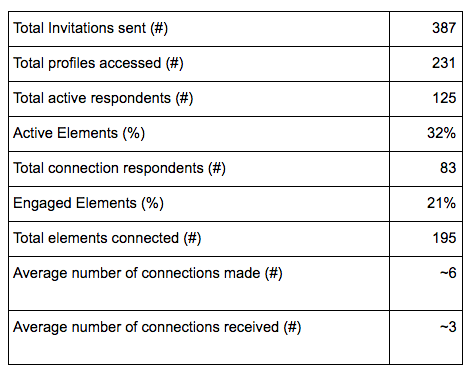
[ap_spacing spacing_height="15px"]
As all the participants on the mapping exercise voluntarily agreed in participating, it was expected that they would be curious enough to enrol in the process and identify at least one kind of connection with some other participant. However that was not immediately the case and some “nudging” had to be done during the event…
[ap_spacing spacing_height="20px"]
Three snapshots of the network
We considered three different moments in time, Moment 1,2 and 3, described below.
[ap_spacing spacing_height="10px"]
Moment One (M1) — Immediately before event
This first “moment” is a snapshot of the network immediately before the roadshow started. It allowed us to observe the engagement of the participants with the exercise without any direct, personal communication from us.
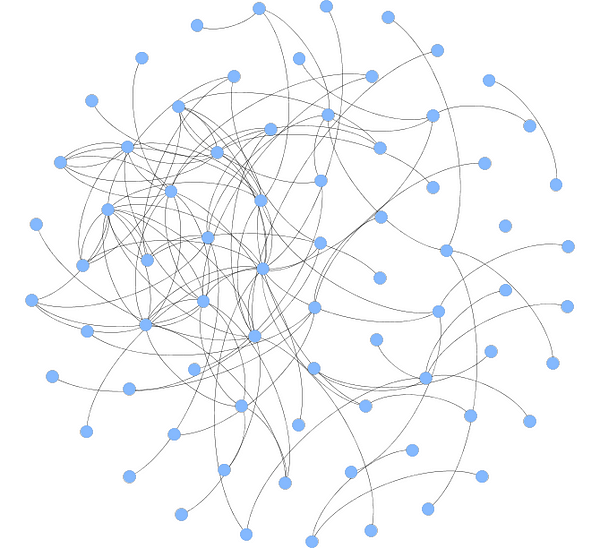
By this time a great majority of the connections established was of the type “I do not know this person but I would like to meet her/him”, which created the expectation that the event might be the place where the connections become real.
If we exclude all the orphan elements, elements that have signaled they wanted to participate in the mapping but hadn’t provided any information yet, we get the mini networks of Figure 2.
[ap_spacing spacing_height="10px"]
Moment two (M2) — Immediately after event
This time period was chosen to assess the relevance of the event on the networking exercise. This snapshot was taken immediately after the event had finished.
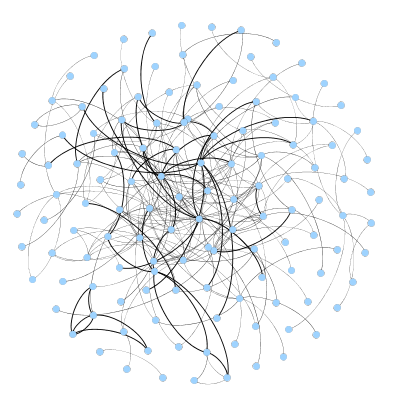
In fact, during the event, participants were able to understand the importance of the mapping exercise, which lead to an increase on the number of elements participating actively on the mapping exercise during the three days of the roadshow. The number of elements with connections increased to 146 (+78%) while the total number of connections reached the 385 connections (+128%).
[ap_spacing spacing_height="10px"]
Moment Three (M3) — One week after event
Two days after the event, a last reminder was sent to all participants to incentivize their final participation. We included a new type of connections, reflecting the ones made during the event. M3 represents the final configuration of the network one week after the event.
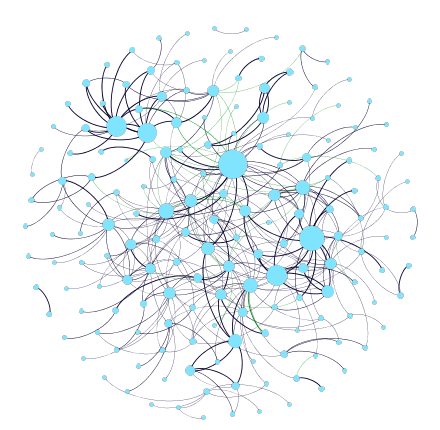
This final network is shown in Figure 4 and it shows a slower growth than the one observed at M2, as it is formed by 195 elements (+33%) and 564 connections (+46%). Moreover, from the 179 new connections identified, only 33 (18,4%) correspond to the new type, i.e, connections made during the event and are represented in light green.
[ap_spacing spacing_height="20px"]
Summary of network structural metrics
After all the talk above, here’s what you need to know about the network evolution in numbers. We distinguish between M3 and M3* where M3* is the analysis of the network including the potential “I would like to meet” connections. This is a optimistic “what if” scenario in which participants actually made it to actually meet the people they identified in mapping as ““I do not know this person but I would like to meet her/him.”.

[ap_spacing spacing_height="20px"]
Here’s a brief glossary of the above terms:
1- Nodes: total number of people in the network
2- Edges: total number of connections established between people in the network
3- Density: ratio between total number of edges and the theoretical number of possible edges if all nodes where connected to each other.
4- Diameter: the shortest path between the two most distant nodes of the network. Gives you an idea of how many people, on average, lie between two people on the edges of the network.
5- Average Degree: average number of edges (or connections) each node (or person) has. This includes connections made and received.
6- Average weighted Degree: same as above but this time weighted using the strength of the edges the point to or from the node.
[ap_spacing spacing_height="20px"]
Characterising the Ecosystem
[ap_spacing spacing_height="15px"]
DISCLAIMER:
It is important to note here that nothing can be truly stated about the actual social network formed by the participants. This will forever remain a mystery as it is impossible to collect all the data from people’s social connections.
What we can do, is to make statements regarding the evolution of the mapping exercise, how the event contributed to the map and how our personal, live invitation and demo contributed to the buying in of the participants into the exercise.
[ap_spacing spacing_height="15px"]
From the network formed around the event Everyone a Changemaker, it is also useful to understand the role that different people have on the network and how their role evolved over the time of making the graph.
Using Gephi to perform social network analysis, we’ve taken a look at how the key metrics evolved from Moment 2 (M2) to Moment 3 (M3) for the top five elements.
We’ve anonymised the names for privacy concerns and limited our analysis to the top 5 nodes
The tables below show this ranking for the two moments when considering all existing connections.
The “Social Hubs” — Degree Centrality
The elements that have the highest number of connections (measured by degree centrality) are those that act as social centers of the network, having around them a significant number of other elements and therefore being able to act as local connector. We show here only the ranking by weighted degree, ignoring the directionality of the connections.
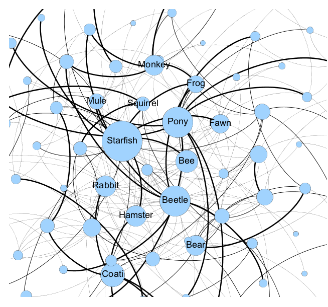
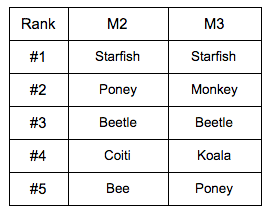
[ap_spacing spacing_height="15px"]
Starfish maintained its position as the node with more connections and there is a new element (Monkey) that was clearly very visible during the event and therefore climbed up to the top 5 ranking of degree centrality.
The “Pop-Ups” — Betweenness Centrality
The Pop-Up elements are identified using the betweenness centrality, and we called them that way as they are the elements that most of the times appear on the shortest path between two other elements.
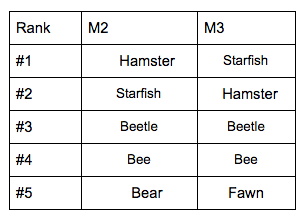
[ap_spacing spacing_height="15px"]
Betweenness measures how strong that node’s role as broker or bottleneck is. Nodes with high betweenness detain some level of control over the flows within the network.
Remember that high betweenness doesn’t necessarily mean high visibility, importance or even gregariousness. Sometimes it is the absolute opposite. These are usually the “unsung heros” or “the sand in the works”. There should be no statement made about Starfish’s popularity of even role during the event. But clearly, the event had an effect of linking Starfish to different subclusters of the network.
Matching skills available with their demand
The event Everyone a Changemaker was all about promoting collaboration. Some of the best ways to trigger collaboration is by:
- Sharing common interests and motivations
- By revealing win-win situations, where you skills match someone else’s needs.
Both of these questions were included on our survey; in addition to asking about one’s interests, the participants were asked about the skills/talents that they could offer to this changemakers’ network and the skill/talents they would like benefit from the network.
We matched the skills requested with the skills offered and plotted both on the chart below.
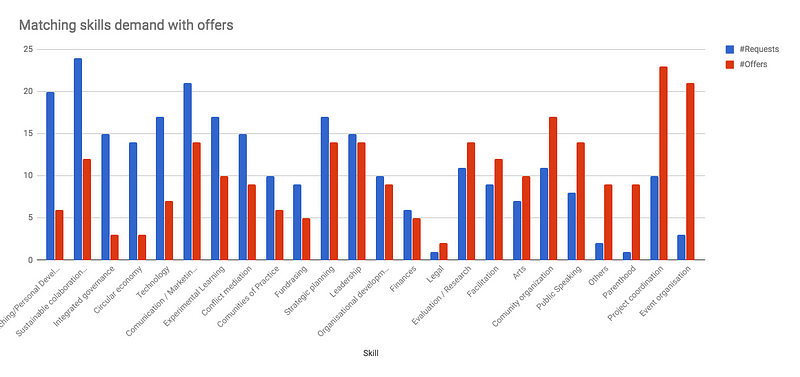
Personal development and coaching, Sustainable collaboration and integrated governance are high on the demand list but are unmatched in the size of offer. In the opposite end, there appears to be a lot of people offering skills of event organization, project coordination and parenthood that don’t have a corresponding match in requests.
Below is a chart where we subtracted the #Offers from #Request to get a sense of how balanced and unbalanced is the “internal market” of skills: apparently leadership, organizational development and finances are pretty much covered in this ecosystem
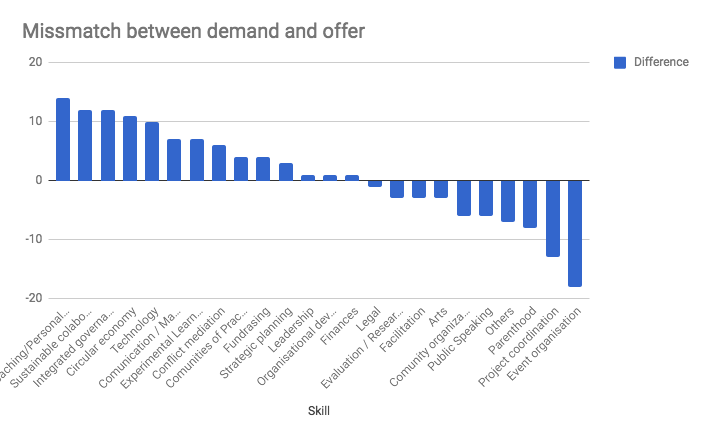
It was possible to observe that the network has a matching potential of 44% as all the 25 different types of skills and talents are present on both lists (offers and needs), although only on 10 of those skills the offers surpass the needs.
Of course this analysis is very limited because one person can provide training for hundreds of people.
But it is very interesting to think how this information can be used to strategically design training opportunities for the ecosystem.
[ap_spacing spacing_height="20px"]
Final thoughts
[ap_spacing spacing_height="15px"]
Using SNA for Impact Assessment
From all of the question we posed to participants, the one we were most curious about was whether new ties were being forged during the event. We know from Granovetter’s work on the Strength of Weak Ties that it is these new connections, established in serendipitous conditions, that have the potential to be transformative and spark innovation. This is especially so in the context of social innovation ecosystems.
Although the event did not include a specifically designed networking moment, except for the coffee breaks, people did naturally connect.
From the analysis above we dare to make the following statements:
- The event changed slightly the network structure increasing connectivity and increasing a few nodes’ centrality. This was a desired outcome and was expected given the visibility these elements had during the event. [ap_spacing spacing_height="10px"]
- The event contributed to the establishment of at least 33 new weak ties in the ecosystem. It would be interesting to follow up on these weak ties to see how they evolve over time. [ap_spacing spacing_height="10px"]
- About 300 new weak ties remain to be created and a carefully designed and facilitated network weaving moment during the event the could have contributed to this. This is the yet untapped potential of the network. How can we promote these new connections? [ap_spacing spacing_height="10px"]
- This exercise contributed to a better perspective on the social innovation ecosystem and it currents skills and needs, providing hints as to where we should invest our training budget. [ap_spacing spacing_height="10px"]
Next steps for network weavers
So, what is next?
Our motto is “keep weaving”. And that is our final recommendation to all of you who participated in the mapping. As stated above, there are about 300 weak connections to be forged. Check out our Kumu map, find your name and check who is wanting to connect with you. Engage in the discussion using the comments box under your profile. Share your social media profiles, update your bio and connections. Be curious about who is wanting to meet you.
We are also aware that for some participants, expectations were high, trying to understand how to make the best use of the network formed around the event. Ignition is the keyword: how to ignite the kindling of the weak connections? Connections can be strengthened by having common purposes and ideas but nothing does it better then working together. Simply doing “stuff” together like organizing a think thank and meet ups around topics.
Innovation is a product of serendipity, weak ties and a pinch of purposeful action. Network weaving to promote serendipity and weak ties is all in your hands. As long as you weave purposefully.
We are doing our part!
originally published at Medium on June 6, 2018
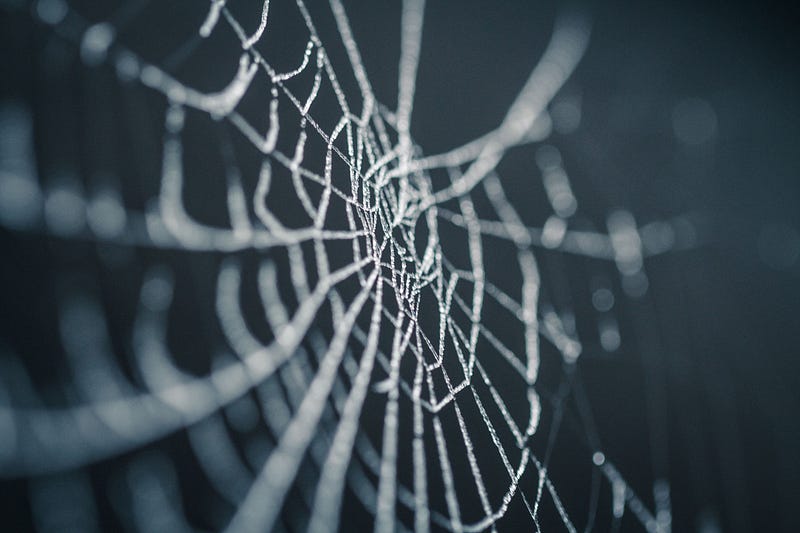
Weaving the Weavers : Efforts to co-create global learning and peer assist
[ap_spacing spacing_height="20px"]Let´s be honest Network Weaving is super fascinating. There are so many activities that we, network weavers, can contribute to to make communities vibrant and effective. Surely, you have your own story and connection to what got you into network weaving. We can seize modern technologies to connect and and share these stories and our learnings.
There is a Facebook group called Network Weaving that currently has about 1800 members. There already has been a vivid exchange of resources and learning through posts and comments. At the beginning of this year some members began further deepening the potential of this amazing community. There are efforts to build a network map and the establishment of regular online formats. In this blog post I will give a short overview of what has been happening so far and how you may participate in the journey.
[ap_spacing spacing_height="20px"]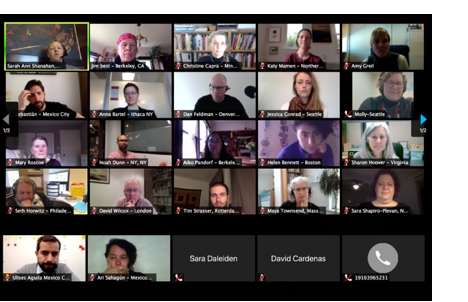
[ap_spacing spacing_height="20px"]
Purpose and Needs
Both the mapping efforts and the virtual cafe identified the needs in the community. Both groups found similar themes and purposes, which cover:
- To help the community discover its identities, building trust-based relationships, and encouraging/facilitating collaborations and learning.
- To further build the field of network weaving, understand its potential and role in systemic change.
- To deepen information flows, to connect related capacities and to attract more abundance to our work.
[ap_spacing spacing_height="10px"]
What has been happening
The network mapping journey
The journey to create a useful network map is highly participative and members of the network weavers facebook group are encouraged to join in any step of the process that is the right fit for them. There are three distinct phases that we are working through; First, we are taking the time to envision and get a better sense of what the community wants, needs and values. Once we have that clarity we’ll move into a technical phase where we’ll build the map. Finally, we’ll work together to make sense of what we are seeing in that map. We kicked off the envisioning phase with twenty seven members of the Facebook group in a zoom session with the larger group having been invited to contribute their perspective in a survey.[ap_spacing spacing_height="10px"]
The Master Mappers have extensive experience with network mapping. Christine Capra, Sarah Ann Shanahan, Maya Townsend, Lisa Negstad, Jim Best and Drew Mackie serve with their efforts and knowledge to facilitate learning, increase the awareness regarding passions and relationships within our community, and to develop the mapping skills of network weavers. This is the process of the mapping and as you see you can work closer with the Master Mappers, fill in surveys and attend the convenings.
[ap_spacing spacing_height="10px"]
Next Meeting on the 2nd April 9:00 -10:30 a.m. CT
Register at:
https://zoom.us/meeting/register/3e12488a815da90c8c34be5db4a05ad8
[ap_spacing spacing_height="20px"]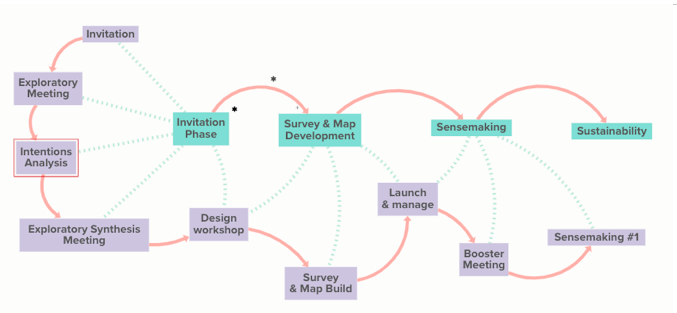
[ap_spacing spacing_height="20px"]
The Virtual Cafes, hosted by an open group of facilitators each month, aim to intensify learning, peer assistance and our service to systemic changes. There have been two cafes so far and the next one is coming up at the 4th of April. The hosts are currently Tim Strasser, Nenad Maljković, Ben Roberts, Jim Best, Keala Young and Adrian Röbke. The hosting group is open. Whomever wants to contribute is very welcome! In the last cafe on the 7th of March we explored our learning wishes and already dove into some of them in an open space, which is one of the many interactive formats we will use to have fun. These wishes to which you can add anytime are a basis for further explorations and journeys.
[ap_spacing spacing_height="20px"]
Event Link: https://www.facebook.com/events/248389826079525/?event_time_id=248389829412858
So this is about it. Personally, I feel lots of excitement and curiosity about what we can co-create as a global community. After just three gatherings I have made lots of good connections and I am sure that really cool ideas will emerge when we get together! Looking forward to seeing and hearing you soon!
[ap_spacing spacing_height="10px"]
Adrian Röbke
[ap_spacing spacing_height="20px"]
Photo by Kyle Glenn on Unsplash
9 Things Teams Need for Successful Collaboration
Across the U.S. and Canada, multi-stakeholder collaborative networks are addressing the systemic issues and wicked problems that cannot be solved by any one organization or institution alone.
In the past 5 years here at Circle Forward, we’ve been working with these collaborative networks addressing regional food security, large scale landscape conservation, public health, economic and community development, and more.
[ap_spacing spacing_height="25px"]
These networks distribute their work through “circles.”
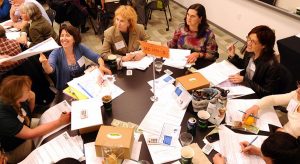
There are “circles” that maintain the strategy of the whole initiative, sometimes called a steering team, coordinating group, stewardship team, catalyst group, etc; and there are “circles” that take on specific strategies or projects, called working groups, teams, clusters, constellations, committees, etc. These circles often self-organize and have autonomy to set their own agendas, within the larger purpose of the network.
When circles within collaborative networks are operating by consent, which we recommend, they need at least 9 practices for working together effectively. (Thanks to John Buck for his support in the first version of this list!)
[ap_spacing spacing_height="25px"]
1. Purpose
A circle has a reason for existence, shared and consented to by all its team members. The team’s purpose supports the overall network’s purpose. This purpose and the values on which it is based must be codified in writing and accessible to members. Decisions are measured by how well they move the circle toward its purpose.
[ap_spacing spacing_height="25px"]
2. Transparency
There must be ways for the circle to access all the information it needs to make its decisions. This does not mean that all information is available to all people all the time, especially where there are clear reasons to maintain confidentiality. At the same time, having a default position of openness to share information builds trust. It supports more equitable access to the information needed to make decisions and greater engagement.
[ap_spacing spacing_height="25px"]
3. A Memory System
A circle has a mind of its own. As such, circles should maintain short-and long-term memory systems. Typically these systems take the form of a collection of documents, meeting records, and written processes and instructions that are easy to retrieve and use. It includes clear descriptions of how the network operates and how to participate.
[ap_spacing spacing_height="25px"]
4. Coordination, Facilitation, and Communication
Circle participants link and work with each other, other circles, and the wider network. They need platforms for sharing information and communicating like those described in the Network Weaver’s Communication Ecosystem free download. And they need systems of support that promote access and equity of participation.
[ap_spacing spacing_height="25px"]
5. Feedback
Circles improve their effectiveness by using feedback loops to gain knowledge through experience. We call this iterative, incremental approach the Action-Reflection Cycle. (Click the image for a free download)
It includes structures for assessing, measuring, learning and responding to feedback. Feedback must especially be sought from people on the margins to sustain a culture of consent.
[ap_spacing spacing_height="25px"]
6. Trust
As Steven Covey observed, success in collaboration moves at the speed of Trust. Trust is built in collaborative networks when members make space for difficulty, such as interpersonal or inner conflict. They get really good at giving and receiving feedback, to be accountable to each other. Trust has a chance to develop when people accept their blind spots and listen to each other’s viewpoints. Healthy circles are social places where joy, laughter, and energy are signs of the work moving forward.
[ap_spacing spacing_height="25px"]
7. Equity and Voice for Affected Parts of the System
“Nothing about me without me” needs to become standard operating procedure; in other words, people have a voice in decisions that affect them. Success in systems-level change depends on authentic participation from all parts of the system. Across race, gender, class and other differences, healthy circles learn about how cultural and historical contexts affect people. They seek to realize the highest potential in each individual. Consent-based processes give people a range of tools to operationalize equity and make wiser decisions.
[ap_spacing spacing_height="25px"]
8. Emergent Creativity
Collaborative networks form because problems are wickedly complex. Healthy circles within these networks are willing to explore the complexity of the issues. They support leaders who say “I don’t know,” and are willing to enter realms of uncertainty with curiosity. They make space for different ways of knowing and honor intuition. They see the world as deeply interconnected, asking what’s really going on here; how does a small problem perhaps reflect systemic issues? They discover elegant solutions that emerge from the context.
[ap_spacing spacing_height="25px"]
9. Continuous Development
Given the constantly dynamic nature of networked organizations, circles need a great deal of flexibility in relation to their environment. To respond effectively, collaborative teams must develop continuously. Development means learning, teaching, and researching in interaction with the common purpose. It means being open to change, including personal change, as a result of what we learn and experience.
As part of their development, circles need to think about succession. They need processes to add and remove members and processes to easily assemble and disassemble their circles.
[ap_spacing spacing_height="25px"]
When woven together with the keystone principle of Consent, these 9 areas of practice will keep your collaborative governance network “circling forward.”
Originally published on January 27, 2019 at CircleFoward.us
